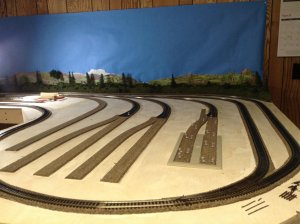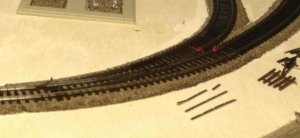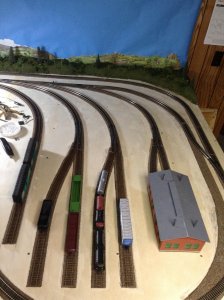Raincoat2
Well-Known Member
Here's a real rookie question regarding DC wiring:
Context: I'm at the beginning of my layout build, still laying track and beginning to do the wiring. The photo below shows my (small) trainyard (hey, I'm limited in space ). The mainline is the outside track that comes in from the left and continues on the right-side outside track. There's a turnout in the front of the photo nearest you - it's a Peco electrofrog, and leads into the trainyard. In this building and testing phase, I have wires for the main buss attached at various points to the track, but all are not connected yet - I'm just testing stuff by hooking power through alligator clips to one of the sets of wires, so this part of the layout is not all wired yet.
). The mainline is the outside track that comes in from the left and continues on the right-side outside track. There's a turnout in the front of the photo nearest you - it's a Peco electrofrog, and leads into the trainyard. In this building and testing phase, I have wires for the main buss attached at various points to the track, but all are not connected yet - I'm just testing stuff by hooking power through alligator clips to one of the sets of wires, so this part of the layout is not all wired yet.
Problem: When the front picture switch is set for the outside track, the engine runs fine. When I switch to the inner track, the engine stops wherever it is on the outside track.
Is that because I'm using an electrofrog rather than an insulfrog? If so, rather than pull the switch up and replace with an insulfrog, is there a way to wire the electrofrog so power is supplied to all tracks all the time? Or is there another solution? Replace the Peco with an Atlas turnout, perhaps? Some other solution?
Thanks for your help.

Context: I'm at the beginning of my layout build, still laying track and beginning to do the wiring. The photo below shows my (small) trainyard (hey, I'm limited in space
Problem: When the front picture switch is set for the outside track, the engine runs fine. When I switch to the inner track, the engine stops wherever it is on the outside track.
Is that because I'm using an electrofrog rather than an insulfrog? If so, rather than pull the switch up and replace with an insulfrog, is there a way to wire the electrofrog so power is supplied to all tracks all the time? Or is there another solution? Replace the Peco with an Atlas turnout, perhaps? Some other solution?
Thanks for your help.




